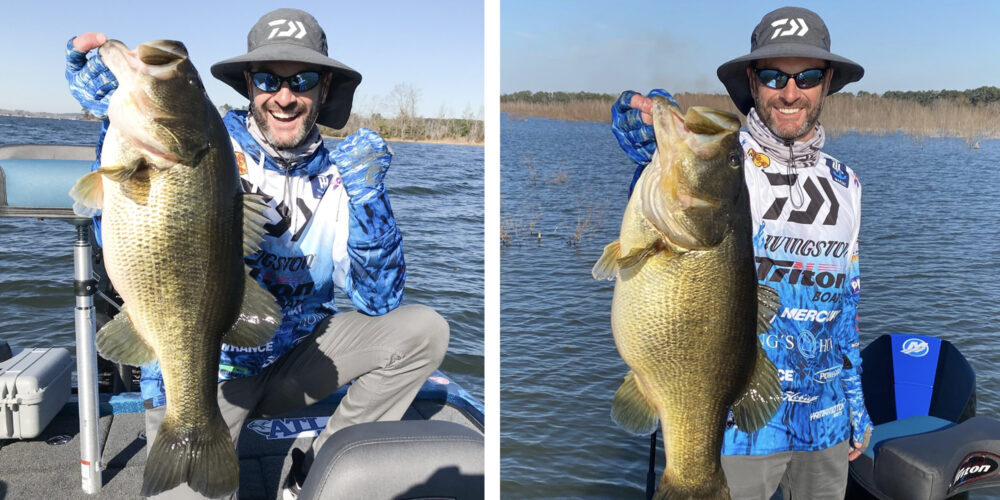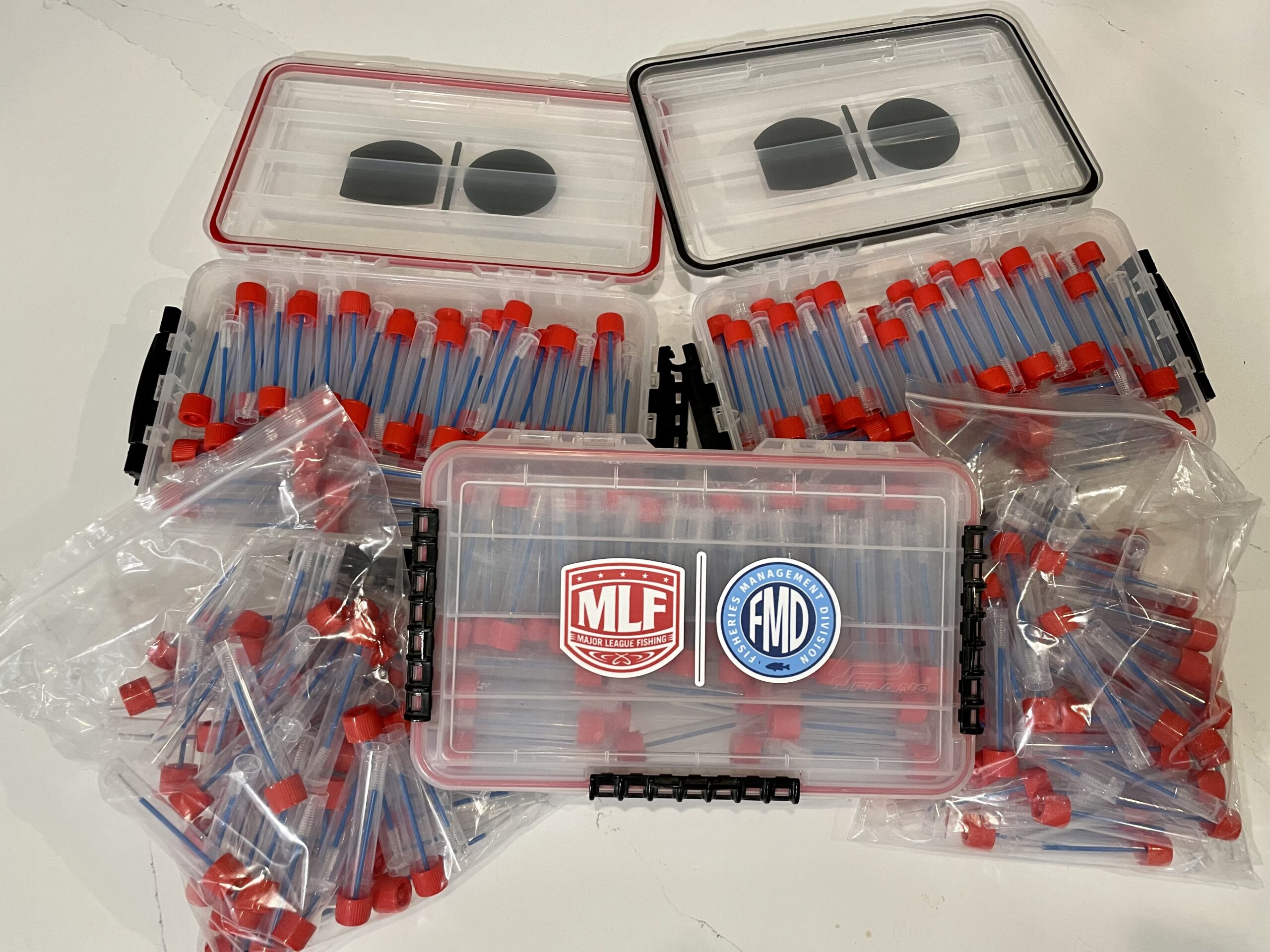Two successful years of MLF Lunker DNA Initiative Data has been analyzed

For the past two seasons, MLF officials and anglers have collected DNA samples from largemouth bass caught over 7 pounds. The program started in 2021 on the Bass Pro Tour, and over the years we refined our DNA sampling methods, tested materials and eventually, in 2022, expanded our program to the Tackle Warehouse Pro Circuit and the Toyota Series events, where an MLF live release boat is on-site. With the 2023 season starting this month, it feels like the right time to refresh everyone on the procedure and purpose. We’ll also announce the results that we recently received from Auburn’s Aquatic Genomics Lab within the School of Fisheries, Aquaculture and Aquatic Sciences.
The procedure for collecting DNA has been refined to the point that it’s extremely quick and simple. We provide our officials and release boat teams and several self-contained sampling tubes at the beginning of each day of competition. When a fish over 7 pounds is caught, it’s weighed and officially recorded onto the paper scorecard, then the angler has a choice to allow a sample to be taken. In some cases, with the fish’s health and competition in mind, the angler opts out of collecting a sample and releases the fish. If the angler wants to collect a sample, the official simply removes the cap from the DNA collection tube and scrubs the tongue of the fish with the included brush, which collects mucus and skin cells from the tongue. It takes about 10 seconds to collect a viable sample.

Once the official finishes, they can screw the cap back onto the tube and fill out the label with the angler’s information. For the Tackle Warehouse Invitationals and Toyota Series events, the procedure is similar, with the live release boat captains collecting the data following the weigh-in.
The goal of the MLF Lunker DNA Initiative sample collection is to determine if there are genetic trends in the DNA of larger fish specific to a fishery, state or latitude within the United States. We aren’t really trying to find the overall population level of Florida versus native genetics within a fishery, but instead looking specifically at the fish that are at the upper end of the population. We can create projects that help to measure population-level genetics and we’ve done this with individual angler groups. Once our samples are analyzed, we provide the complete data set to all state agencies for their own use.
In 2021, we collected 25 viable samples as we were testing materials, procedures and labs:
- Nine from Sam Rayburn Reservoir in Texas
- Four from Jordan Lake in North Carolina
- Two from Falls Lake in North Carolina
- One from Lake Travis in Texas
- Three from Lake Harris in Florida
- Two from Lake Griffin in Florida
- Four from Lake Chickamauga in Tennessee
The results come in percent of Florida versus native genetic, as well as what percentage of that genetic comes from one source which indicates how integrated the genetic is within the family lineage. For Sam Rayburn, we found that Zach Birge’s 7-10 fish was a 100% pure Florida largemouth. All of the other fish ranged from 61.43% to 84.29% Florida genetic, with an average of the nine fish being 76.83% Florida. Jordan Lake had the first 50% Florida/ 50% native fish in our collection, but the average of the four fish was 60% Florida. Falls Lake had a higher Florida percentage, at an average for the two fish being 75%. Lake Travis’ fish was 61.43% and all the fish from Florida were 99.7% or higher Florida genetic. Finally, the four fish from Lake Chickamauga ranged from 37.30% to 54.3% Florida genetic with an average of 48.45%. These are all small sample sizes and no real population conclusions should be made from the results yet.
The 2022 results arrived to the MLF FMD inbox about a week ago. It included 77 samples, but only 74 viable samples:
- Five samples came from Bussey Brake WMA, Louisiana
- Four from Caney Creek Reservoir, Louisiana
- 46 fish from Lake Fork, Texas
- Nine fish from Lake Guntersville, Alabama
- 11 fish from Sam Rayburn Reservoir, Texas
- Two fish from Lake of the Ozarks, Missouri
Bussey Brake WMA is the home for Randy Howell’s Bass Pro Tour record 12-14 fish. Unfortunately, it’s one of the three fish that didn’t have a viable sample. The remaining four Bussey Brake WMA fish ranged from 84.78% to 98.53% Florida genetic with an average of 93.6% Florida genetic. Caney Creek Reservoir also had one non-viable sample with the remaining three fish ranging from 58.82% to 97.06% Florida genetic and an average of 75.40% Florida genetic.
Lake Fork provided the largest data set of genetic samples we collected during an MLF event with 45 out of 46 samples being viable. The range for Florida genetic was as low at 28.33% and as high 88.1% with an average of 57.42%. Seven out the 44 fish were found to be below 50% Florida genetic. The largest of those seven fish, a 9-4, had the lowest Florida genetics of the entire sample with 28.33%. Five fish were over 10 pounds, this included Brandon Coulter’s 10-2, Dustin Connell’s 10-7, Birge’s 10-14, Alton Jones Sr.’s 11-2, and Bradley Roy’s 11-11 fish. These fish ranged from 55.56% to 88.1% Florida genetic with an average of 64.04%. The highest Florida genetic in a fish was Connell’s 10-7.
This data set is eye-opening to the fact that Florida genetic may have an important role in advanced size growth, but that some fisheries are predisposed to grow fish to a trophy size naturally. We need more data above 10 pounds to determine if Florida genetic specifically allows fish to become the top tier within Lake Fork, or if the fishery itself is the driving force behind advanced growth.

The nine samples from Guntersville were collected by live release boat captains during the Toyota Series event. They ranged from 26.09% to 75% Florida genetic with an average of 56.38%. Three fish sampled were below 50% Florida genetic and the two largest fish — an 8-12 and an 8-7 — account for the highest and lowest Florida genetic within the Guntersville sample. In 2023, we expect the Bass Pro Tour anglers to increase the sampling within Guntersville to provide a more robust data set to help us understand more of the genetic potential within the reservoir.
The 11 Sam Rayburn fish in the sample ranged from 39.29% to 100% Florida genetic with an average of 61.14%. This is a lower Florida genetic compared to the 2021 data for Sam Rayburn. The largest fish provided by Cole Moore was an 11-15 fish with a 48% Florida genetic. Additionally, two other fish over 10 pounds were sampled including Jeff Bridges’ 10-6 and Randy Millender’s 10-2 which had a 95% and 62.5% Florida genetic respectively. When combined with the 2021 data, the 20 samples have a genetic range 39.29% to 100% Florida genetic with an average of 68.2%. In total, 18 of the 20 fish had a Florida genetic of 50% or higher. As this data set grows, it will inevitably start to show trends for the fishery related to growth beyond 7 pounds and into double digits.
The final two DNA samples collected come from the live release boat at the 2022 Toyota Series event. These fish were 97.82% and 85% Florida genetic. Statistically, a fish over 95% Florida genetic is a Florida genetic largemouth bass. These fish represent the furthest northern latitude that we have collected in our DNA Initiative project and give us a known northern boundary at this point. This may in fact be the furthest known Florida bass collected in anyone’s data; we will be discussing with other fisheries professionals to see if that is true.
We are excited to continue to expand the MLF Lunker DNA Initiative in 2023 and look forward to collecting more samples this season on the Bass Pro Tour, Tackle Warehouse Invitationals and at Toyota Series events. We are also working with individual groups to help with determining population-level data in small impoundments. Look for the results of the Paintsville Lake, Kentucky, project coming very soon. If you are interested in a project of your own, feel free to reach out to our biologist at [email protected].
All data is certified by Auburn University through the Peatman Lab Genetics Lab.